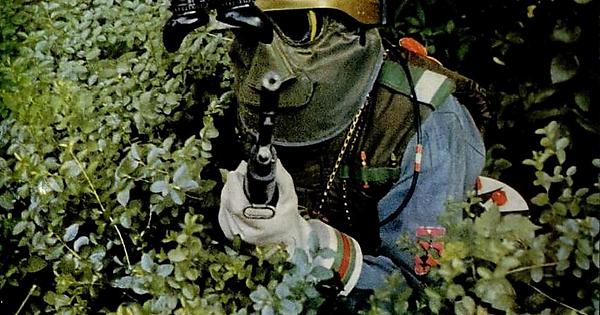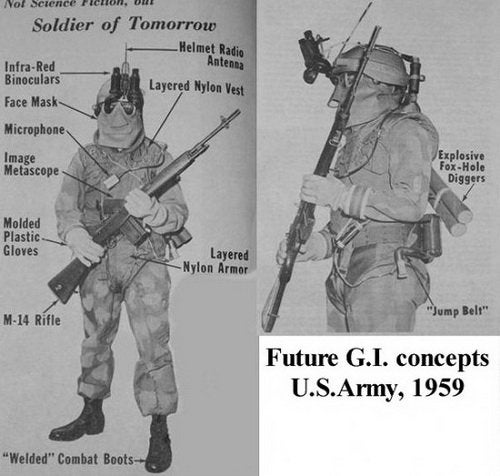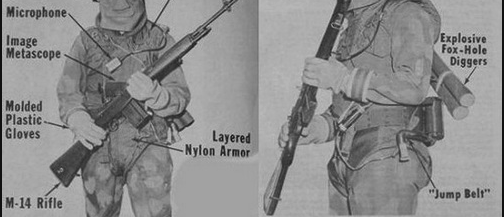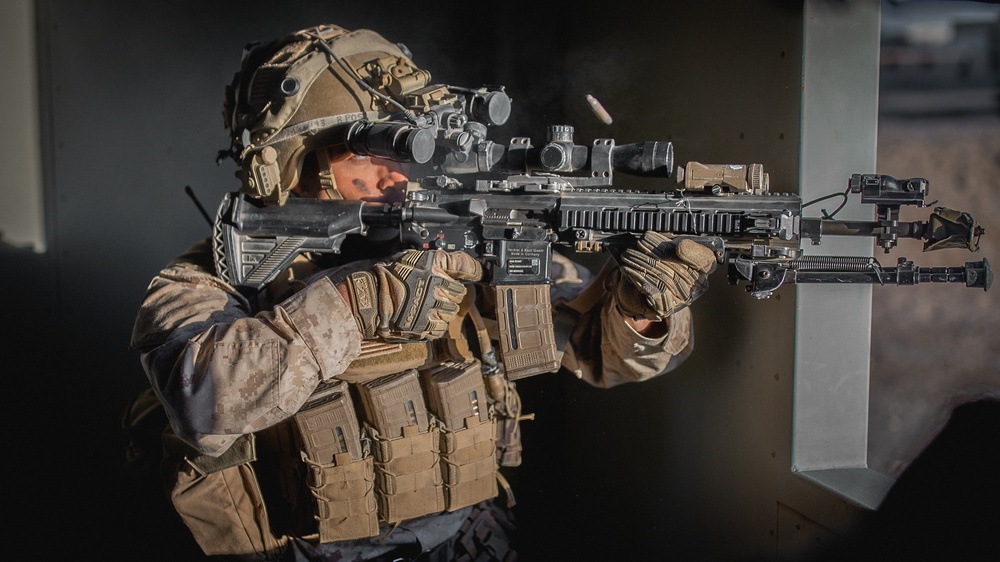
I recently stumbled across an old image of an atomic age soldier with a messy caption describing the image as “Future G.I. Concepts, 1959.” Although I can’t seem to find the exact origin of this specific image, there are several color photos from Life magazine from way back when that show some of the gear it contained in living color. Literally. Their take on the equipment of the Future G.I. is quite fascinating, and well worth exploring through 2021’s lens.

There is an atomic age character to the gear and setup. I mean that literally. The Future G.I. would fight on an atomic battleground radiated by nuclear destruction! Or so they thought. That idea drives a lot of the gear chosen, and we’ll explore why
Helmet Radio Antennae and Microphone
While I don’t think transistor helmets ever came to be, there are certainly way more comms within a squad today than ever before. Communication can be the key to victory, and the better a team or platoon can communicate, the better they can execute a plan. Modern squad comms allow for easy inter-squad and platoon communication, and offer more powerful radios for communication with higher.

Beyond radios, we’ve seen the development and use of tablets to send pictures, maps, and more to Marines with the Marine common tablet. The Future G.I. program knew comms were critical but likely couldn’t conceive how advanced they would become.
Infra-Red binoculars
I’ve never seen Infrared spelled infra-red, but SIC and all that. The Infrared goggles or binoculars are night vision! In 1959, night vision had existed for quite some time, but the problem was the size, clarity, and power sources required for them to function. Despite all that, the Future G.I. concept really nailed what future night vision would look like.

It’s helmet-mounted, portable, lightweight, and would give the average infantryman the ability to own the night. Those pesky Russians would never see it coming!
Face Mask And Goggles
The face mask makes the soldier look a bit terrifying but was reportedly a heat-resistant mask. The heat of a nuclear explosion might be a bit much for even this piece of kit, but I imagine this wasn’t a constant piece of worn PPE. I do appreciate the goggles. These days, eye protection isn’t just a must-have but a necessity when you step outside the wire.

Goggles were issued when I was in, but the most common eye protection were simple ballistic glasses. The goggles were quite handy in dust storms, and a nuclear desert would present some sand you surely didn’t want in your eyes.
Layered Nylon Vest…and Diaper
The layered nylon armor didn’t necessarily predict the rigid, rifle-proof ceramic plates we’d have today but wasn’t too far off from traditional soft body armor we’ve seen in service for years. The Future G.I. and his armor would be frag and shrapnel resistant and potentially capable of stopping handgun fire. Layered nylon works a lot like Kevlar, but Kevlar proved to be the most resistant to perpendicular pressure, and therefore better for the future of warfare.

But layered nylon offered the soldier ballistic protection as well as radiation resistance. That’s not to say that Kevlar doesn’t offer the same radiation resistance. It just wasn’t developed until 1965, which would have been little if a nuclear war kicked off in 1961. The vest also included what appears to be some kind of crotch protection as well. I have a kevlar crotch protector on my issued plate carrier, so I guess it’s not all that off, at least until circa 2013ish.
Image Metascope
An Image metascope is a non-IR, passive form of night vision that was somewhat revolutionary for the time. These little systems are fascinating, and shrunk night vision down to a much more portable form than the infrared systems of the day. They had very limited range and very low visibility, but they were better than nothing. The metascopes served in Vietnam, but not too much longer after that.
Molded Plastic Gloves
Like goggles, gloves have also become a necessary piece of PPE for the deployed G.I. The Future G.I. clearly knew the value of protecting one’s hands. Plastic doesn’t seem like the best choice since it tends to melt, but I’m betting it was meant to resist radiation, rather than fire and explosions.

M14 Rifle
Nope, the M14 was the shortest-serving service rifle for a reason: it mostly sucked. This pic would have been much more appropriate with a AR 10 or even the earliest of AR 15 models, which had just hit the market in 1959.
“Welded “Combat Boots
When they say welded, they don’t mean welded in the way you think. What they mean is molded combat boots. Directly molded soles were much stronger than stitched soles and much stronger than glued soles. This was relatively new and fancy at the time and made for super tough boots. We’d begin to see molded boots become the standard in Vietnam, so I guess this prediction was dead on.

Jump Belt
I did some digging and assumed this was some form of airborne thing my Marine self just didn’t understand. Boy, was I wrong! No, you see, this belt would attach to a jump pack… or what’s essentially a jet pack! Oh man, the defense engineers in the 1950s ruled. Sadly, we don’t have jump packs or jet packs of any type quite yet, though the British Royal Marines have been experimenting with them for things like ship interdiction. That doesn’t mean the Future G.I. concept was wrong. We just haven’t gotten that far yet.
Explosive Fox-Hole Diggers
My favorite piece of this getup is the explosive fox-hole diggers. I don’t know how they work and assume they would be heavy, and also loud… oh and super dangerous. But dang, I hate digging fighting holes.
If I could just plant a bomb and blow up my own, I would happily do so. Maybe weirdest of all… I remember an SOI instructor saying these were coming out soon when I went through training. I guess they’ve been in development since 1959!
The Future G.I. Meets the Modern G.I.

While the Future G.I. wasn’t entirely accurate, the themes were there. Troops would be armored, carry radios, see in the dark, and wear both modern eye and hand protection as well as super-tough boots. It’s fascinating to see what they envisioned in 1959 and how it aligned with 2021. I wonder what we’ll see in 2051. Maybe I’ll get my jet pack.
